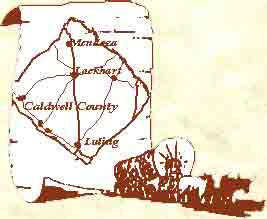
![]()

|
Lockhart ~ ca 1840
The county seat of Caldwell County is located on U.S. Highway 183 in almost the center of the county. The town was named for Byrd Lockhart on whose league the town was built. In 1840, when the Battle of Plum Creek took place, there were only two families living in the area, both about five miles east of present-day Lockhart. This large Indian battle was very important to Texas history and especially to this area because it opened up South Central Texas to a more rapid settlement. One year later, the Plum Creek post office was established at the home of Isham Good, with Good as postmaster.
Over the next few years, families began to settle in within what is now the city limits of Lockhart and, in 1848, Caldwell County was created by a division from Gonzales County. On the original handwritten petition, the county was to have been called Plum Creek County and the county seat Lockhart Springs. In committee, though, the name Plum Creek was struck through and changed to Caldwell, honoring Matthew Caldwell, an early Indian fighter and a hero of the Battle of Plum Creek.
In 1848 there was only one store in Lockhart, owned by W. B. Coffee. By 1850 there were about 40 establishments in Lockhart. The Lockhart Academy, chartered in 1850, was located in a two-story building across the street from the Episcopal Church. The Academy building also served as the meeting location for the first Masonic Lodge. Rapid economic development took place from 1850 to 1860. A weekly newspaper, the Lockhart News Echo, was published by Isabel Stewart. The population grew to several hundred people, and the public square was completely filled up with buildings. Several hotels provided accommodations for travelers.
After the War Between the States, John Jacob Myers of Lockhart was one of the first to gather a herd of Texas longhorns and drive them north to Salt Lake City to sell. Over the next 20 years, a number of Texas cattle men would raise herds of cattle and move them north, coming through Caldwell County. They would bed the cattle down east of Lockhart on Plum Creek and ride into town at night to visit the saloons and have a good time.
In 1887 the Missouri, Kansas, and Texas Rail Line began to bring increased development. A connection from Lockhart to the San Antonio and Aransas Pass Railroad that ran through Luling was completed in 1889. A “through line” from Smithville to San Marcos gave Lockhart another boost in economic growth. Population grew steadily as the twentieth century began, with much of the economy based on agriculture production in the surrounding area. Lockhart had a cotton seed oil mill and a compress in 1901. Various plants that processed other agricultural products were also built.
A Victorian-type courthouse was built in 1894 and, after restoration, is still in use as the seat of county government, as well as attracting photographers and visitors. In 1898, the Clark Library was built from a gift of Dr. Eugene Clark. It is reputed to be the oldest continuously operating library in the state.
Nicknamed the “Barbecue Capitol of Texas”, the town has a number of historic buildings that are sometimes featured as background location for movie settings. One such structure, built in 1908-09 to serve as the Caldwell County Jail, represents a rare example of the Norman castellated style of architecture and is now used to house the Caldwell County Museum.
Source - Plum Creek Almanac, Vol. 15, No. 2,
Fall 1997 and Caldwell County Kin: The First 150 Years published by the
Genealogical and Historical Society of Caldwell County, November 2000.
The Plum Creek Almanac is a project
of The Genealogical and Historical Society of Caldwell County.
 The Genealogical and Historical Society
of Caldwell County Copyright © 1963-2017 The Genealogical and Historical Society
of Caldwell County Copyright © 1963-2017 Updated 08/16/2017 |

